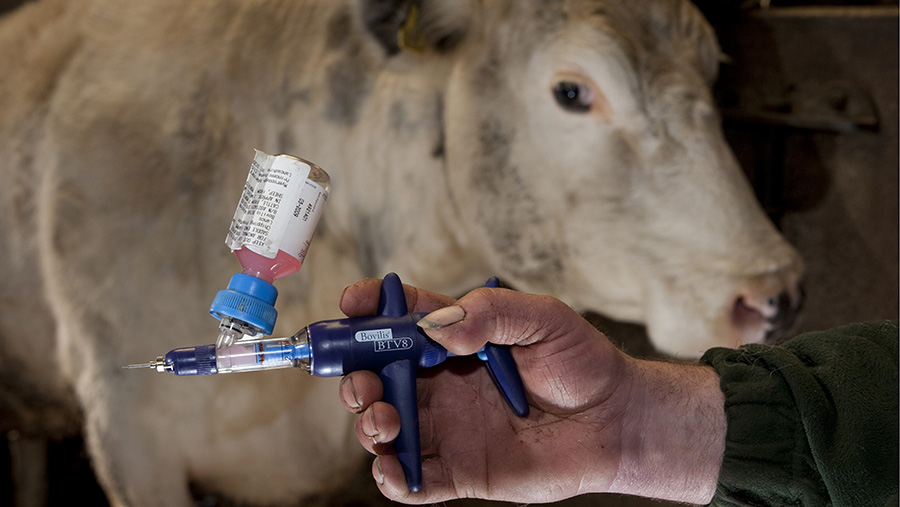Bluetongue strike ‘most likely’ as farmers vote to vaccinate
 John Eveson/FLPA/ImageBROKER/Rex/Shutterstock
John Eveson/FLPA/ImageBROKER/Rex/Shutterstock Livestock farmers are being urged to remain vigilant over Bluetongue after a recent risk assessment by the Animal and Plant Health Agency (APHA) revealed an outbreak in late summer was “most likely”.
The first outbreak of bluetongue for four years was confirmed in the Allier region of central France last August.
Since it was first detected, surveillance work uncovered 173 outbreaks of the bluetongue serotype virus 8 (BTV-8) as of 4 February, prompting movement restrictions and vaccinations for exported livestock.
See also: Fears grow over bluetongue threat to UK
Last month, Defra said the risk of the virus reaching UK shores was low, but it has since said an outbreak is up to 80% likely by the end of the summer.
In a statement released on Thursday (11 February), following the latest risk assessment, Defra said:
“As an approximation and with a high level of uncertainty, we consider the risk of an incursion in a cool spring (for example, with average temperatures of less than 12-15C) to be between 5% and 10%; later in the summer at between 33% and 60% and by the end of the summer at 60-80%.”
It added: “This would be the result of infected midges being blown across from France to the south-east of England.
“The risk of an incursion in the UK is highly dependent on the level of disease on the continent, the proximity to the UK of cases in the rest of Europe and the weather, including temperature and wind direction.”
Defra said an outbreak would also hinge on the ability of the French authorities to control disease over the low vector activity period.
Government deputy chief vet Simon Hall said the risk of outbreak was “difficult to predict at this stage”, but confirmed Defra has robust disease-surveillance procedures in place and was working closely with the devolved administrations and the livestock industry.
“The risk of incursion from infected midges is difficult to predict at this stage because it is highly dependent on the level of disease on the continent, the proximity to the UK and the weather.
“Animal keepers should remain vigilant for any signs of disease and report any suspicions to their vet and the APHA immediately.”
NFU chief adviser on animal health and welfare, Catherine McLaughlin, said farmers should speak to their vet about vaccination.
“We are taking the threat of bluetongue seriously and urge all ruminant keepers to maintain vigilance for signs of disease.
“Vaccine is effective and we recommend farmers have a conversation with their veterinary surgeon to inform their decision based on their business risk.”
Professor Peter Mertens of The Pirbright Institute, the centre for bluetongue epidemiology research in Europe, said they were “well prepared” for a possible outbreak.
“Diagnostic tests used to detect the virus were developed at The Pirbright Institute so we are confident that these tests are fast and reliable.
“It would appear that the virus circulating now is almost identical to the virus outbreak in 2007 therefore we know exactly what to expect and are well prepared.”
Farmers Weekly poll
In an online poll, a majority of Farmers Weekly readers said they would vaccinate against bluetongue if the disease arrived on our shores.
Of the 38 votes cast, 53% were in favour of vaccinating against the disease. However, 34% said they had not decided.
The remaining 13% voted “No” when asked: “Will you vaccinate against bluetongue if it arrives in the UK?”
Last month, the British Veterinary Association (BVA) called on farmers to recognise the risk of bluetongue reaching the UK and urged them to consider investing in vaccinating their livestock against bluetongue.
The NFU agreed, telling Farmers Weekly there is a “fairly good risk” of bluetongue spreading England from France.
Industry organisations, including the NFU and British Veterinary Association, are lobbying pharmaceutical manufacturers to kick-start production of the bluetongue vaccine ahead of a potential outbreak in the UK.
However, manufacturers will only begin production if there is a guaranteed market for the vaccine, which cost farmers about 80p a dose during the previous UK outbreak in 2007.
Bluetongue facts
- Bluetongue disease affects sheep, cows and goats, causing painful hooves, lameness and reproductive problems
- Bluetongue is carried and spread by midges
- Main signs of bluetongue in sheep are ulcers in the mouth, discharge of mucus, drooling from mouth or nose and swelling of the mouth, head, neck and the coronary band
- Bluetongue is a notifiable disease, which means the Animal and Plant and Health Agency (APHA) must be told immediately if a case is suspected
- Animals may also have red skin, fever, lameness and breathing problems
- Cattle are the main carriers of bluetongue and can show some of the same symptoms as sheep, but generally they do not show any signs of the disease
